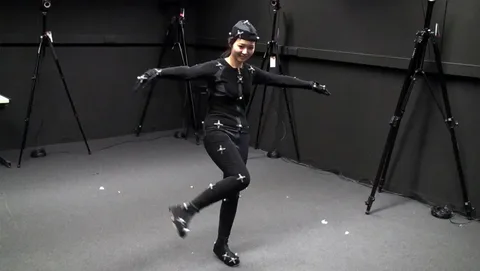3D Motion Capture System Market Technological Advancements Reshaping Industry Outlook Today

Introduction
The 3D Motion Capture System Market is undergoing a revolutionary transformation fueled by rapid technological advancements. From next-gen sensor technology and real-time rendering to AI-driven motion prediction and cloud computing, these innovations are pushing the boundaries of what motion capture systems can achieve. As industries strive for greater accuracy, speed, and scalability, understanding the implications of these advancements is critical to staying ahead in an evolving market.
Evolution of 3D Motion Capture Technology
3D motion capture (MoCap) systems were initially developed to improve animation fidelity in films and video games. Over time, technological progress has enabled broader adoption across verticals such as biomechanics, industrial automation, sports science, and virtual production.
Traditional vs. Modern Systems
Earlier systems were primarily optical and relied on complex marker-based setups. While highly accurate, they required controlled environments and extensive post-processing. Today’s systems are increasingly markerless, portable, and powered by artificial intelligence—making them more efficient and adaptable to real-world settings.
Key Technological Advancements
1. Markerless Motion Capture
Markerless systems use advanced computer vision algorithms to capture human motion without physical markers or suits. This reduces setup time, enhances user comfort, and enables tracking in natural environments.
-
Impact: Widely adopted in clinical gait analysis, live performances, and mobile applications.
2. Artificial Intelligence and Machine Learning
AI algorithms now help identify motion patterns, predict trajectories, and reduce noise in data. ML-based systems learn from previous sessions to improve tracking accuracy over time.
-
Impact: Drives performance optimization in sports and rehabilitation, and enables motion anomaly detection in healthcare.
3. Real-Time Rendering and Feedback
Real-time processing allows users to visualize captured motion instantly, crucial for industries like filmmaking, VR development, and sports coaching.
-
Impact: Enables live feedback and immediate corrections during motion recording sessions.
4. Cloud-Based Processing and Collaboration
Cloud platforms enable remote access, faster rendering, and collaborative workflows across multiple locations.
-
Impact: Supports hybrid production environments and accelerates cross-geographical research and development.
5. Inertial and Wearable Sensor Innovations
Inertial measurement units (IMUs) and wearable sensors have become smaller, more affordable, and more accurate. They offer an alternative to optical systems, particularly in outdoor or mobile scenarios.
-
Impact: Expands motion capture applications to industrial training, tactical defense, and sports biomechanics.
6. Haptic Feedback and XR Integration
Combining motion capture with extended reality (XR) and haptics creates highly immersive environments for simulation training and entertainment.
-
Impact: Enhances realism in VR/AR applications, especially in defense, education, and gaming.
Sector-Wise Impact of Technological Advancements
Entertainment and Media
Virtual production using real-time MoCap technology has transformed how content is created. Actors’ performances are captured live and rendered into digital avatars in real time.
-
Trend: Virtual studios and metaverse platforms are heavily investing in these tools.
Healthcare and Rehabilitation
Technological improvements now allow for detailed biomechanical analysis and patient-specific tracking.
-
Use Case: Physical therapists use real-time data to track recovery progress and adjust treatment plans accordingly.
Sports and Performance
Elite athletes rely on 3D motion capture to analyze and optimize their movements. Technological innovations enable frame-by-frame analysis and prediction of potential injuries.
-
Trend: Wearable sensors with AI analysis are becoming standard in performance labs.
Robotics and Industrial Applications
Human motion data helps train robots to mimic tasks or collaborate safely with humans.
-
Use Case: In industrial automation, MoCap improves human-robot interaction and workflow efficiency.
Challenges and Considerations
Despite the advancements, several challenges remain for widespread adoption.
-
Cost and Accessibility
High-end systems remain expensive, although modular and subscription models are helping reduce the entry barrier. -
Data Privacy and Security
With systems capturing detailed human movement and behavior data, compliance with privacy regulations is increasingly important. -
Skill Gap
Proper system setup, data interpretation, and integration still require trained professionals in many use cases. -
Hardware Limitations in Extreme Conditions
Some sensors may underperform in outdoor environments or under poor lighting conditions, although newer models are addressing these issues.
Future Outlook: What Lies Ahead
Technological momentum is expected to continue, with emerging innovations including:
-
Neural Motion Capture – Capturing subtle expressions and neural motor signals using brain-computer interfaces.
-
Low-Latency Cloud Rendering – Making live, high-definition remote motion capture feasible for widespread applications.
-
Automated Motion Analysis – AI-driven auto-segmentation and motion classification tools will reduce human effort in processing and interpreting data.
These trends will not only broaden the market but will also democratize access to motion capture systems, especially in developing regions and emerging industries.
Strategic Takeaways for Stakeholders
-
Invest in Scalable Systems – Future-ready systems must be modular, cloud-compatible, and easy to upgrade.
-
Prioritize Cross-Platform Compatibility – Integration with existing VR, AI, and healthcare systems adds significant value.
-
Encourage Training and Onboarding – Offering user-friendly software and remote support will be key for expanding market reach.
-
Focus on Application-Specific Innovation – Tailoring solutions for specific sectors (e.g., sports, prosthetics, animation) enhances product-market fit.
Conclusion
Technological advancements are not just enhancing the performance of 3D motion capture systems—they’re fundamentally reshaping the industry. From markerless tracking and real-time rendering to cloud integration and AI-enhanced feedback, these innovations are driving broader adoption across sectors. As companies compete to offer faster, smarter, and more flexible systems, those who prioritize innovation and application-specific value creation will lead the next wave of growth in the global 3D motion capture system market.
- Art
- Causes
- Crafts
- Dance
- Drinks
- Film
- Fitness
- Food
- Games
- Gardening
- Health
- Home
- Literature
- Music
- Networking
- Other
- Party
- Religion
- Shopping
- Sports
- Theater
- Wellness


